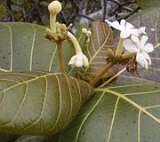
Guettarda speciosa
Encyclopedia
Guettarda speciosa, colloquially called beach gardenia, or zebra wood, is a species of shrub
in the family
Rubiaceae
found in coastal habitats in tropical areas around the Pacific Ocean, including the coastline of central and northern Queensland and Northern Territory in Australia, and Pacific Islands, including Micronesia, French Polynesia and Fiji, Malaysia and Indonesia and the east coast of Africa. It reaches 6 m in height, has fragrant white flowers, and large green prominently-veined leaves. It grows in sand above the high tide mark.
.
It was originally described by Carl Linnaeus. The genus was named in honour of the 18th century French naturalist Jean-Étienne Guettard
, while the specific epithet is derived from the Latin
speciosus 'showy'.
(Pteropus mariannus) feeds on the fruit and flowers, acting as a vector for the dispersal of seeds.
Shrub
A shrub or bush is distinguished from a tree by its multiple stems and shorter height, usually under 5–6 m tall. A large number of plants may become either shrubs or trees, depending on the growing conditions they experience...
in the family
Family (biology)
In biological classification, family is* a taxonomic rank. Other well-known ranks are life, domain, kingdom, phylum, class, order, genus, and species, with family fitting between order and genus. As for the other well-known ranks, there is the option of an immediately lower rank, indicated by the...
Rubiaceae
Rubiaceae
The Rubiaceae is a family of flowering plants, variously called the coffee family, madder family, or bedstraw family. The group contains many commonly known plants, including the economically important coffee , quinine , and gambier , and the horticulturally valuable madder , west indian jasmine ,...
found in coastal habitats in tropical areas around the Pacific Ocean, including the coastline of central and northern Queensland and Northern Territory in Australia, and Pacific Islands, including Micronesia, French Polynesia and Fiji, Malaysia and Indonesia and the east coast of Africa. It reaches 6 m in height, has fragrant white flowers, and large green prominently-veined leaves. It grows in sand above the high tide mark.
Taxonomy and naming
Alternate names in the Cook Islands include ‘Ano, Hano, Fano, and Puapua. The last is also used in Samoa, and the similar Puopua in Tonga. It is known as Utilomar in the Marshall IslandsMarshall Islands
The Republic of the Marshall Islands , , is a Micronesian nation of atolls and islands in the middle of the Pacific Ocean, just west of the International Date Line and just north of the Equator. As of July 2011 the population was 67,182...
.
It was originally described by Carl Linnaeus. The genus was named in honour of the 18th century French naturalist Jean-Étienne Guettard
Jean-Étienne Guettard
Jean-Étienne Guettard , French naturalist and mineralogist, was born at Étampes, near Paris.In boyhood, he gained a knowledge of plants from his grandfather, who was an apothecary, and later he qualified as a doctor in medicine...
, while the specific epithet is derived from the Latin
Latin
Latin is an Italic language originally spoken in Latium and Ancient Rome. It, along with most European languages, is a descendant of the ancient Proto-Indo-European language. Although it is considered a dead language, a number of scholars and members of the Christian clergy speak it fluently, and...
speciosus 'showy'.
Description
It is a perennial shrub or small tree 2–6 m (7–20 ft) tall by 1–3 m (3–10 ft) wide with smooth creamy grey bark. The large oval-shaped leaves are 15–23 cm (6–9 in) long by 10–18 cm (4–7 in) wide. Dark green and smooth above with prominent paler veins, they are finely hairy underneath. Flowering is from October to May, the fragrant white flowers are 2.5–3 cm (1–1½ in) long with 4–9 lobes. These are followed by sweet-smelling globular hard fruit, measuring 2.5–2.8 × 2.2–2.5 cm (1 × 1 in), which mature September to March.Distribution and habitat
Guettarda speciosa is found in coastal habitats in tropical areas around the Pacific Ocean, including the coastline of central and northern Queensland and Northern Territory in Australia, and Pacific Islands, including Micronesia, French Polynesia and Fiji, Malaysia and Indonesia and the east coast of Africa. As its name suggests, the beach gardenia grows on beaches and sandy places above the high tide level.Ecology
The Mariana Fruit BatMariana Fruit Bat
The Mariana Fruit Bat , also known as the Mariana flying fox, and the fanihi in Chamorro is a megabat that is found only on Guam, the Northern Mariana Islands and Ulithi . Habitat loss has driven it to endangered status and it is listed as threatened by the U.S. Fish & Wildlife Service...
(Pteropus mariannus) feeds on the fruit and flowers, acting as a vector for the dispersal of seeds.

